key Lancia Ypsilon 2001 Owner handbook (in English)
[x] Cancel search | Manufacturer: LANCIA, Model Year: 2001, Model line: Ypsilon, Model: Lancia Ypsilon 2001Pages: 191, PDF Size: 2.45 MB
Page 95 of 191
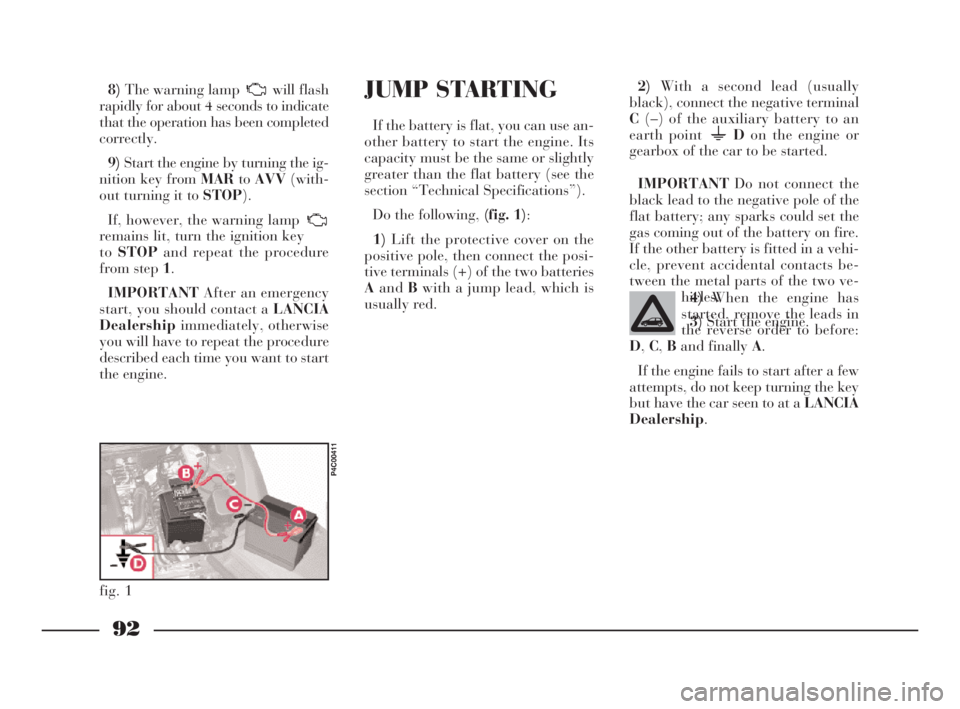
92
G
8)The warning lamp will flash
rapidly for about 4 seconds to indicate
that the operation has been completed
correctly.
9)Start the engine by turning the ig-
nition key from MARtoAVV(with-
out turning it to STOP).
If, however, the warning lamp
remains lit, turn the ignition key
toSTOPand repeat the procedure
from step 1.
IMPORTANTAfter an emergency
start, you should contact a LANCIA
Dealershipimmediately, otherwise
you will have to repeat the procedure
described each time you want to start
the engine.JUMP STARTING
If the battery is flat, you can use an-
other battery to start the engine. Its
capacity must be the same or slightly
greater than the flat battery (see the
section “Technical Specifications”).
Do the following, (fig. 1):
1)Lift the protective cover on the
positive pole, then connect the posi-
tive terminals (+) of the two batteries
AandBwith a jump lead, which is
usually red.2)With a second lead (usually
black), connect the negative terminal
C(–) of the auxiliary battery to an
earth point Don the engine or
gearbox of the car to be started.
IMPORTANTDo not connect the
black lead to the negative pole of the
flat battery; any sparks could set the
gas coming out of the battery on fire.
If the other battery is fitted in a vehi-
cle, prevent accidental contacts be-
tween the metal parts of the two ve-
hicles.
3)Start the engine.
4)When the engine has
started, remove the leads in
the reverse order to before:
D,C,Band finally A.
If the engine fails to start after a few
attempts, do not keep turning the key
but have the car seen to at a LANCIA
Dealership.
fig. 1
P4C00411
4C090-119 ING 11-03-2008 12:00 Pagina 92
Page 110 of 191
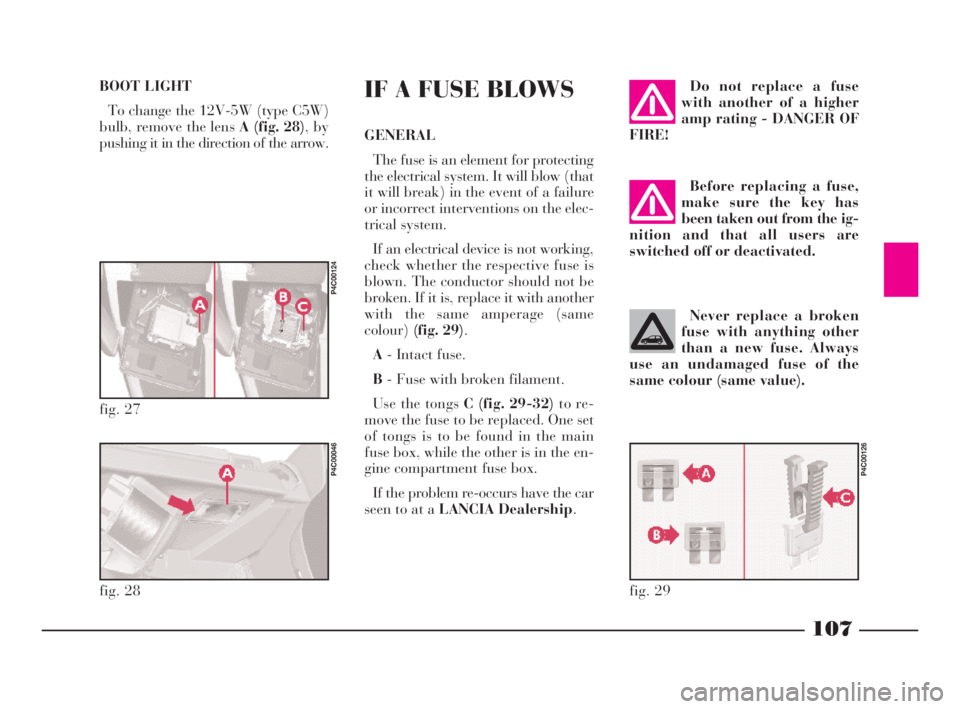
Before replacing a fuse,
make sure the key has
been taken out from the ig-
nition and that all users are
switched off or deactivated.
107
fG
BOOT LIGHT
To change the 12V-5W (type C5W)
bulb, remove the lens A (fig. 28), by
pushing it in the direction of the arrow.IF A FUSE BLOWS
GENERAL
The fuse is an element for protecting
the electrical system. It will blow (that
it will break) in the event of a failure
or incorrect interventions on the elec-
trical system.
If an electrical device is not working,
check whether the respective fuse is
blown. The conductor should not be
broken. If it is, replace it with another
with the same amperage (same
colour)(fig. 29).
A- Intact fuse.
B- Fuse with broken filament.
Use the tongs C (fig. 29-32)to re-
move the fuse to be replaced. One set
of tongs is to be found in the main
fuse box, while the other is in the en-
gine compartment fuse box.
If the problem re-occurs have the car
seen to at a LANCIA Dealership.
Do not replace a fuse
with another of a higher
amp rating - DANGER OF
FIRE!
Never replace a broken
fuse with anything other
than a new fuse. Always
use an undamaged fuse of the
same colour (same value).
fig. 27
P4C00124
fig. 28
P4C00046
fig. 29
P4C00126
4C090-119 ING 13-03-2008 12:51 Pagina 107
Page 115 of 191
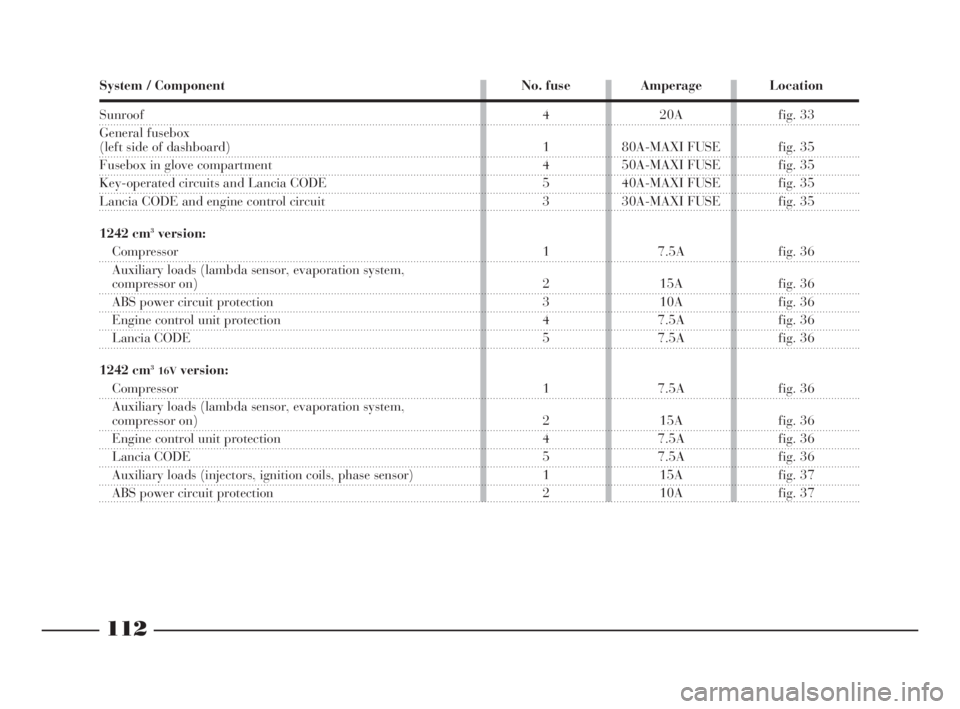
112
fG
System / Component No. fuse Amperage Location
Sunroof
General fusebox
(left side of dashboard)
Fusebox in glove compartment
Key-operated circuits and Lancia CODE
Lancia CODE and engine control circuit
1242 cm
3version:
Compressor
Auxiliary loads (lambda sensor, evaporation system,
compressor on)
ABS power circuit protection
Engine control unit protection
Lancia CODE
1242 cm
316Vversion:
Compressor
Auxiliary loads (lambda sensor, evaporation system,
compressor on)
Engine control unit protection
Lancia CODE
Auxiliary loads (injectors, ignition coils, phase sensor)
ABS power circuit protection4 20A fig. 33
1 80A-MAXI FUSE fig. 35
4 50A-MAXI FUSE fig. 35
5 40A-MAXI FUSE fig. 35
3 30A-MAXI FUSE fig. 35
1 7.5A fig. 36
2 15A fig. 36
3 10A fig. 36
4 7.5A fig. 36
5 7.5A fig. 36
1 7.5A fig. 36
2 15A fig. 36
4 7.5A fig. 36
5 7.5A fig. 36
1 15A fig. 37
2 10A fig. 37
les
00
ed
az-
ve
4C090-119 ING 13-03-2008 12:51 Pagina 112
Page 120 of 191

117
fG
While the car is being
towed with the engine off,
remember that the brake
pedal and steering will require
more effort as you no longer have
the benefit of the brake booster
and power steering. Do not use
flexible cables to tow. Avoid jerk-
ing. Whilst towing, ensure that the
coupling to the car does not dam-
age the surrounding components.Do not extract the igni-
tion key during towing;
leave it at MAR, to prevent
the steering lock engaging and,
provided the electrical system is
not damaged, keep the brake lights
and direction indicators working.
When the ignition key is re-
moved, the steering lock will cut in
thus preventing the steering wheel
from being turned.IF AN ACCIDENT
OCCURS
– It is important to keep calm.
– If you are not directly involved,
stop at least ten metres away from the
accident.
– If you are on a motorway do not
obstruct the emergency lane with your
car.
– Turn off the engine and turn on
the hazard lights.
– At night, illuminate the scene of
the accident with your headlights.
– Act carefully, you must not risk
being run over.
– Mark the accident by putting the
red triangle at the regulatory distance
from the car where it can be clearly
seen.
– If the doors are jammed, do not try
to leave the car by breaking the glass
of the windscreen as the glass is strat-
ified. Side windows and the rear win-
dow can be broken more easily.
4C090-119 ING 13-03-2008 12:51 Pagina 117
Page 121 of 191

118
fG
– Call the emergency services mak-
ing the information you give as accu-
rate as you can. On the motorway use
the special column-mounted emer-
gency phones.
– Remove the ignition keys of the ve-
hicles involved.
– If you can smell petrol or other
chemicals, do not smoke and make
sure all cigarettes are extinguished.
– Use a fire extinguisher, blanket,
sand or earth to put out fires no mat-
ter how small they are. Never use
water.
– In pile-ups on the motorway, par-
ticularly when the visibility is bad,
there is a high risk of other vehicles
running into those already immobile.
Get out of the car immediately and
take refuge behind the guard rail.IF ANYONE IS INJURED
– Never leave the injured person
alone. The obligation to provide as-
sistance exists even for those not di-
rectly involved in the accident.
– Do not congregate around the in-
jured person.
– Reassure the injured person that
help is on its way and will arrive soon.
Stay close by to calm him/her down
in case of panic.
– Unfasten or cut seat belts holding
injured parties.
– Do not give an injured person any-
thing to drink.
– Never move an injured person ex-
cept in the following cases.
– Pull the injured person from the
car only if it risks catching fire, it is
sinking in water or is likely to fall over
a cliff or similar. Do not pull his/her
arms or legs, never bend the head
and, as far as possible, keep the body
horizontal.FIRST-AID KIT
The first-aid kit must at least con-
tain(fig. 45):
– sterile gauze for covering and
cleansing wounds
– bandages of different widths
– antiseptic plasters of different sizes
– a roll of plaster
– a packet of cotton wool
– a bottle of disinfectant
– a packet of paper handkerchiefs
– a pair of scissors with rounded tips
– a pair of pincers
– two haemostatic loops.
4C090-119 ING 13-03-2008 12:51 Pagina 118
Page 128 of 191
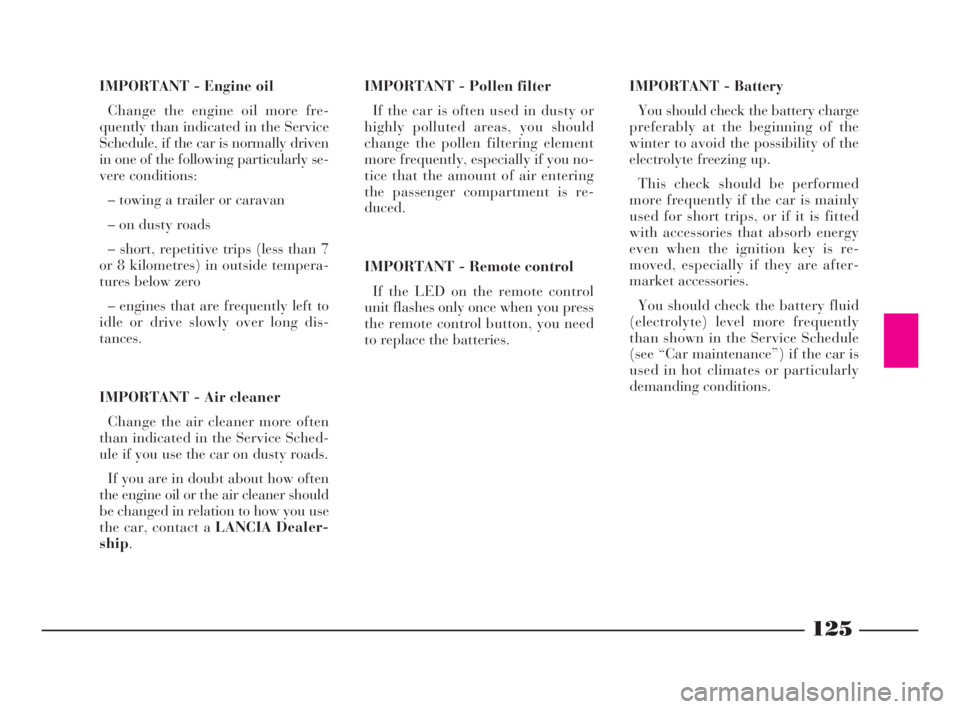
125
G
IMPORTANT - Battery
You should check the battery charge
preferably at the beginning of the
winter to avoid the possibility of the
electrolyte freezing up.
This check should be performed
more frequently if the car is mainly
used for short trips, or if it is fitted
with accessories that absorb energy
even when the ignition key is re-
moved, especially if they are after-
market accessories.
You should check the battery fluid
(electrolyte) level more frequently
than shown in the Service Schedule
(see “Car maintenance”) if the car is
used in hot climates or particularly
demanding conditions. IMPORTANT - Engine oil
Change the engine oil more fre-
quently than indicated in the Service
Schedule, if the car is normally driven
in one of the following particularly se-
vere conditions:
– towing a trailer or caravan
– on dusty roads
– short, repetitive trips (less than 7
or 8 kilometres) in outside tempera-
tures below zero
– engines that are frequently left to
idle or drive slowly over long dis-
tances.
IMPORTANT - Air cleaner
Change the air cleaner more often
than indicated in the Service Sched-
ule if you use the car on dusty roads.
If you are in doubt about how often
the engine oil or the air cleaner should
be changed in relation to how you use
the car, contact a LANCIA Dealer-
ship.IMPORTANT - Pollen filter
If the car is often used in dusty or
highly polluted areas, you should
change the pollen filtering element
more frequently, especially if you no-
tice that the amount of air entering
the passenger compartment is re-
duced.
IMPORTANT - Remote control
If the LED on the remote control
unit flashes only once when you press
the remote control button, you need
to replace the batteries.
4C120-143 ING 11-03-2008 12:01 Pagina 125
Page 133 of 191
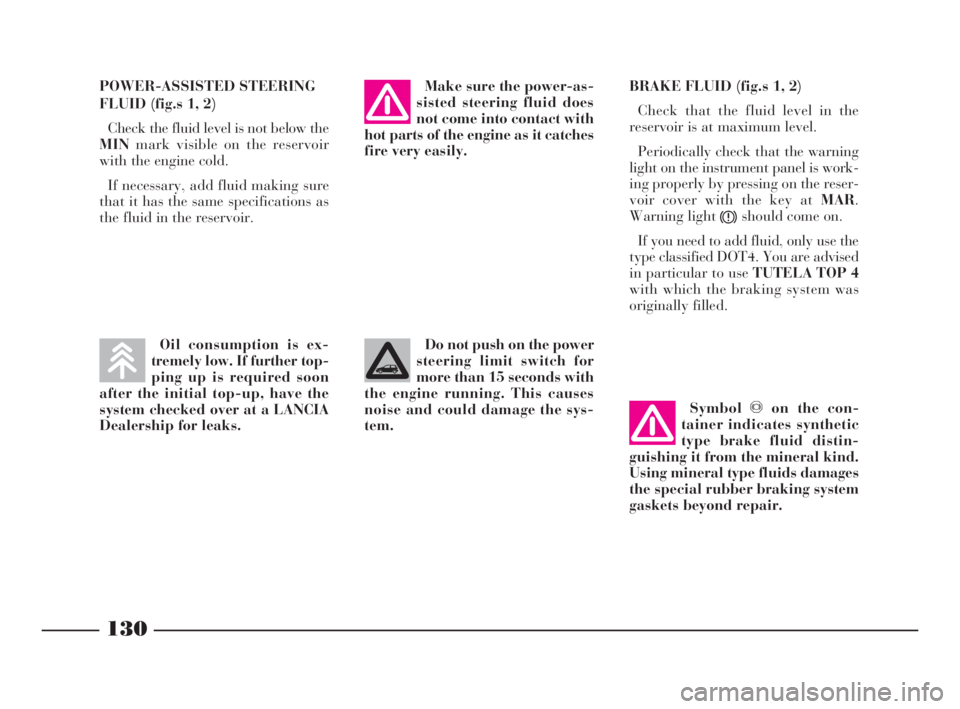
130
G
POWER-ASSISTED STEERING
FLUID (fig.s 1, 2)
Check the fluid level is not below the
MINmark visible on the reservoir
with the engine cold.
If necessary, add fluid making sure
that it has the same specifications as
the fluid in the reservoir.BRAKE FLUID (fig.s 1, 2)
Check that the fluid level in the
reservoir is at maximum level.
Periodically check that the warning
light on the instrument panel is work-
ing properly by pressing on the reser-
voir cover with the key at MAR.
Warning light
xshould come on.
If you need to add fluid, only use the
type classified DOT4. You are advised
in particular to use TUTELA TOP 4
with which the braking system was
originally filled.
Symbolπon the con-
tainer indicates synthetic
type brake fluid distin-
guishing it from the mineral kind.
Using mineral type fluids damages
the special rubber braking system
gaskets beyond repair.
Make sure the power-as-
sisted steering fluid does
not come into contact with
hot parts of the engine as it catches
fire very easily.
Do not push on the power
steering limit switch for
more than 15 seconds with
the engine running. This causes
noise and could damage the sys-
tem.Oil consumption is ex-
tremely low. If further top-
ping up is required soon
after the initial top-up, have the
system checked over at a LANCIA
Dealership for leaks.
4C120-143 ING 11-03-2008 12:01 Pagina 130
Page 137 of 191
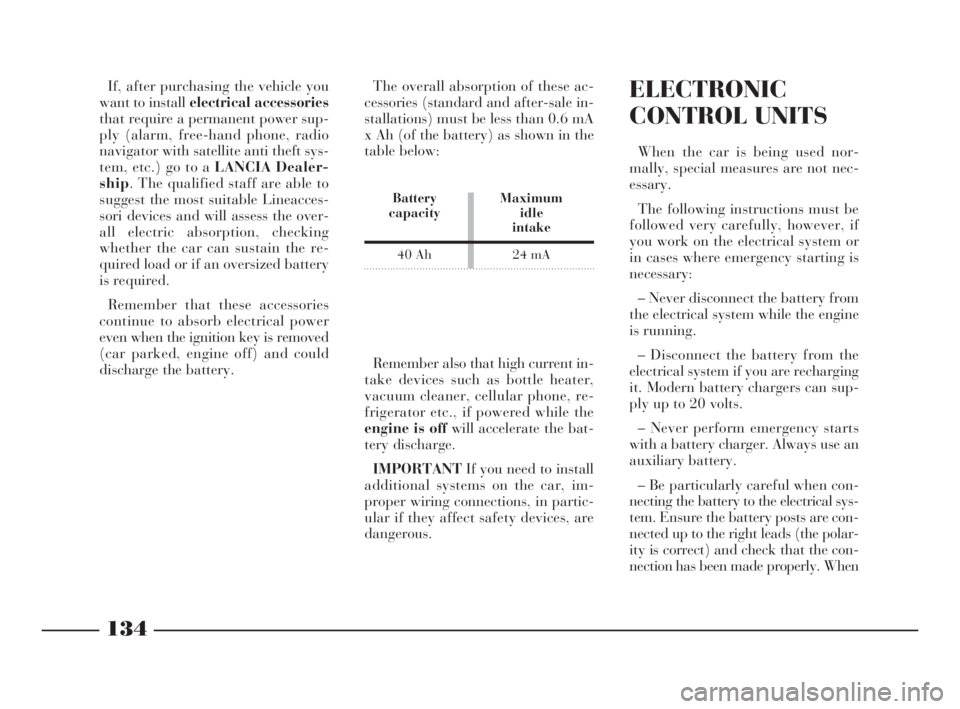
134
G
If, after purchasing the vehicle you
want to install electrical accessories
that require a permanent power sup-
ply (alarm, free-hand phone, radio
navigator with satellite anti theft sys-
tem, etc.) go to a LANCIA Dealer-
ship. The qualified staff are able to
suggest the most suitable Lineacces-
sori devices and will assess the over-
all electric absorption, checking
whether the car can sustain the re-
quired load or if an oversized battery
is required.
Remember that these accessories
continue to absorb electrical power
even when the ignition key is removed
(car parked, engine off) and could
discharge the battery.The overall absorption of these ac-
cessories (standard and after-sale in-
stallations) must be less than 0.6 mA
x Ah (of the battery) as shown in the
table below:ELECTRONIC
CONTROL UNITS
When the car is being used nor-
mally, special measures are not nec-
essary.
The following instructions must be
followed very carefully, however, if
you work on the electrical system or
in cases where emergency starting is
necessary:
– Never disconnect the battery from
the electrical system while the engine
is running.
– Disconnect the battery from the
electrical system if you are recharging
it. Modern battery chargers can sup-
ply up to 20 volts.
– Never perform emergency starts
with a battery charger. Always use an
auxiliary battery.
– Be particularly careful when con-
necting the battery to the electrical sys-
tem. Ensure the battery posts are con-
nected up to the right leads (the polar-
ity is correct) and check that the con-
nection has been made properly. When Remember also that high current in-
take devices such as bottle heater,
vacuum cleaner, cellular phone, re-
frigerator etc., if powered while the
engine is off will accelerate the bat-
tery discharge.
IMPORTANTIf you need to install
additional systems on the car, im-
proper wiring connections, in partic-
ular if they affect safety devices, are
dangerous.
Battery Maximum
capacity idle
intake
40 Ah 24 mA
4C120-143 ING 11-03-2008 12:01 Pagina 134
Page 138 of 191

135
G
SPARK PLUGS
The cleanness and soundness of the
spark plugs are very important for
keeping the engine efficient and pol-
luting emissions down.
The appearance of the spark plug
(fig. 6), if examined by an expert eye,
is a good way of pinpointing a mal-
function even if it has nothing to do
with the ignition system. Therefore if
the engine has problems, it is impor-
tant to have the spark plugs checked
at a LANCIA Dealership.The spark plugs must be
changed at the times spec-
ified in the Service Sched-
ule. Only use the type of plugs in-
dicated: if the heat ratio is less
than required or the life specified
is not guaranteed, problems can
arise.
the battery is reconnected, the injec-
tion/ignition system control unit must
readapt its internal parameters; conse-
quently performance may not be opti-
mal during the first few kilometres af-
ter reconnecting the battery.
– Do not connect or disconnect the
terminals of the electronic units while
the ignition key is at MAR.
– Do not check polarity through
sparking.
– Disconnect the electronic units if
you are electrically welding the car
body. Remove the units if tempera-
tures exceed 80°C (special operations
on the bodywork etc.).
IMPORTANTIf the radio or car
alarm systems are not installed cor-
rectly, they can interfere with the
working of the electronic control units.
Modifications or repairs
to the electrical system
that are performed incor-
rectly and do not take into account
the system’s technical features can
result in malfunctions with the
risk of fire.
Versions Type of spark plug
1.2ChampionRC10YCC
NKG BKR5EZ
1.216VNGK DCPR8E-N
fig. 6
P4C00308
4C120-143 ING 11-03-2008 12:01 Pagina 135
Page 144 of 191

141
G
IMPORTANTCars with optional
“Kaleidos” options (non-standard
personalised paint colours), can be re-
paired in exactly the same way as
other cars painted with standard
colours at your LANCIA Dealership.To wash the car properly:
1)Remove the aerial from the roof
to prevent damaging it when washing
the car in an automatic carwash.
2)Wet the body using a low pressure
jet of water.
3)Wipe a sponge with a slightly
soapy solution over the bodywork,
frequently rinsing the sponge.
4)Rinse well with water and dry
with a jet of air or a chamois leather.
When drying the car, be careful to
get at those parts which are not so
easily seen e.g. the door frames, bon-
net and around the headlights where
water can most readily collect. You
are advised not to take the car into a
closed area immediately, but to leave
it out in the open so any water left can
evaporate more easily.
Do not wash the car after it has been
parked in the sun or while the bonnet
is hot: it could take the shine off the
paint.
External plastic parts must be
cleaned following the usual car wash-
ing procedure. As far as possible avoid parking your
car under trees; the resinous sub-
stances which often drop from certain
types of trees could dull the paint and
increase the possibility of rusting.
IMPORTANTBird droppings must
be washed off immediately and with
great care as their acid is particularly
aggressive.
Detergents pollute water.
For this reason, the car
must be washed in an area
equipped for the collection and
purification of the liquids used
while washing.
IMPORTANTWashing is to be car-
ried out with the engine cold and the
ignition key on STOP. After washing
make sure that the various protections
(rubber sheaths and other guards)
have not moved from their positions
or been damaged.
4C120-143 ING 11-03-2008 12:01 Pagina 141